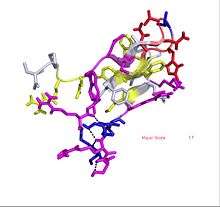Conformational ensembles

Conformational ensembles, also known as structural ensembles are experimentally constrained computational models describing the structure of intrinsically unstructured proteins.[1][2] Such proteins are flexible in nature, lacking a stable tertiary structure, and therefore cannot be described with a single structural representation.[3] The techniques of ensemble calculation are relatively new on the field of structural biology, and are still facing certain limitations that need to be addressed before it will become comparable to classical structural description methods such as biological macromolecular crystallography.[4]
The purpose of conformational ensembles
Ensembles are models consisting of a set of conformations that together attempt to describe the structure of a flexible protein. Even though the degree of conformational freedom is extremely high, flexible/disordered protein generally differ from fully random coil structures.[5][6] The main purpose of these models is to gain insights regarding the function of the flexible protein, extending the structure-function paradigm from folded proteins to intrinsically disordered proteins.
Ensemble calculation techniques
The calculation of ensembles rely on experimental measurements, mostly by Nuclear Magnetic Resonance spectroscopy and Small-angle X-ray scattering. These measurements yield short and long-range structural information.
Short-range structural information
- Chemical Shifts (CS)
- Residual Dipolar Couplings (RDCs)
- J-couplings
- Hydrogen-exchange
- Solvent-accessibility.
Long-range structural information
- Paramagnetic Relaxation Enhancements (PREs)
- Nuclear Overhauser effects (NOEs)
- SAXS topological restraints.
Constrained molecular dynamics simulations
The structure of disordered proteins may be approximated by running constrained molecular dynamics (MD) simulations where the conformational sampling is being influenced by experimentally derived constraints.[7]
Selection of conformers describing the experimental data
Another approach uses selection algorithms such as ENSEMBLE and ASTEROIDS.[8][9] Calculation procedures start by generating a pool of random conformers sampling the conformation space. Theoretical parameters are calculated for each conformer and the selection algorithms create the final ensembles by selecting a set of conformers that are fitting to the experimentally derived constraints.
Availability of structural ensembles
Since the calculation of ensembles rely on lower resolution techniques, the Protein Data Bank is not accepting these models. Recently the Protein Ensemble Database (pE-DB) was released, which is an open access online repository of the structural ensembles and their underlying experimental data. The availability of the ensembles should facilitate the development of validation and evaluation protocols improving the quality and predictive power.
Limitations
Several slightly different ensemble may describe the experimental data equally well, and currently there are no methods to discriminate between ensembles of equally good fit. This renders the identification of the 'best' ensemble impossible.
References
- ↑ Fisher, CK.; Stultz CM. (June 2011). "Constructing ensembles for intrinsically disordered proteins.". Curr Opin Struct Biol. (3). 21 (3): 426–31. doi:10.1016/j.sbi.2011.04.001. PMC 3112268
 . PMID 21530234.
. PMID 21530234. - ↑ Varadi, M.; S. Kosol; P. Lebrun; E. Valentini; M. Blackledge; A.K. Dunker; I.C. Felli; J.D. Forman-Kay; R.W. Kriwacki; R. Pierattelli; J. Sussman; D.I. Svergun; V.N. Uversky; M. Vendruscolo; D. Wishart; P.E. Wright; P. Tompa (January 2014). "pE-DB: a database of structural ensembles of intrinsically disordered and of unfolded proteins.". 42(1) (1): D326–35. doi:10.1093/nar/gkt960. PMC 3964940
 . PMID 24174539. Check date values in:
. PMID 24174539. Check date values in: |access-date=(help); - ↑ Dyson, HJ; P.E. Wright (March 2005). "Intrinsically unstructured proteins and their functions". Nat. Rev. Mol. Cell Biol. 6 (3): 197–208. doi:10.1038/nrm1589. PMID 15738986.
- ↑ Tompa, P. (June 2011). "Unstructural biology coming of age.". Curr Opin Struct Biol. 21 (3): 419–425. doi:10.1016/j.sbi.2011.03.012. PMID 21514142.
- ↑ Communie, G.; J. Habchi; F. Yabukarski; D. Blocquel; R. Schneider; N. Tarbouriech; N. Papageorgiou,; R.W.H. Ruigrok; M. Jamin; M.R. Jensen; S. Longhi; M. Blackledge (2013). "Atomic Resolution Description of the Interaction between the Nucleoprotein and Phosphoprotein of Hendra Virus". PLoS Pathog. 9 (9): e1003631. doi:10.1371/journal.ppat.1003631. PMC 3784471
 . PMID 24086133.
. PMID 24086133. - ↑ Kurzbach, D; G. Platzer; T.C. Schwarz; M.A. Henen; R. Konrat; D. Hinderberger. "Cooperative Unfolding of Compact Conformations of the Intrinsically Disordered Protein Osteopontin". Biochemistry. 52 (31): 5167–5175. doi:10.1021/bi400502c. PMC 3737600
 . PMID 23848319.
. PMID 23848319. - ↑ Allison, J.R.; P. Varnai; C.M. Dobson; M. Vendruscolo (December 2009). "Determination of the free energy landscape of alpha-synuclein using spin label nuclear magnetic resonance measurements". J Am Chem Soc. 131 (51): 18314–26. doi:10.1021/ja904716h. PMID 20028147.
- ↑ Krzeminski, M.; J.A. Marsh; C. Neale; W.Y. Choy; J.D. Forman-Kay (February 2013). "Characterization of disordered proteins with ENSEMBLE.". Bioinformatics. 29 (3): 398–9. doi:10.1093/bioinformatics/bts701. PMID 23233655.
- ↑ Jensen, M.R.; L. Salmon; G. Nodet; M. Blackledge (February 2010). "Defining conformational ensembles of intrinsically disordered and partially folded proteins directly from chemical shifts.". J Am Chem Soc. 132 (4): 1270–2. doi:10.1021/ja909973n. PMID 20063887.